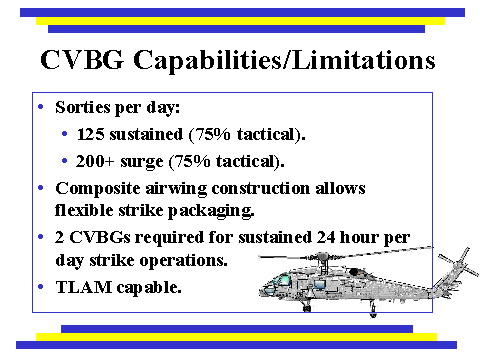




 Due to the proximity of population centers near the sea, naval forces and forward presence can influence world events. Power projection and naval strike assets are integral to US national military strategy. The Navy's vision of the future is captured in the white paper "Forward...From the Sea." This document outlines the Navy's shift from preparing for an open-ocean war at sea with the Soviet Navy to focusing on regional threats to US national interests. "Forward...From the Sea" recognizes the ability of the US Navy to control the sea lanes as well as controlling the "littoral zone," the areas from off the coast to as far inland as necessary to establish a safe zone for entry of additional US forces. ln this way, the Navy and Marine Corps can serve as an "enabling" force, establishing safe beachheads, ports and airfields, and paving the way for follow-on action by Army, Air Force and allied forces.
Due to the proximity of population centers near the sea, naval forces and forward presence can influence world events. Power projection and naval strike assets are integral to US national military strategy. The Navy's vision of the future is captured in the white paper "Forward...From the Sea." This document outlines the Navy's shift from preparing for an open-ocean war at sea with the Soviet Navy to focusing on regional threats to US national interests. "Forward...From the Sea" recognizes the ability of the US Navy to control the sea lanes as well as controlling the "littoral zone," the areas from off the coast to as far inland as necessary to establish a safe zone for entry of additional US forces. ln this way, the Navy and Marine Corps can serve as an "enabling" force, establishing safe beachheads, ports and airfields, and paving the way for follow-on action by Army, Air Force and allied forces.
Aircraft carriers are routinely forward deployed around the world, engaging in joint (U.S. Navy, Marines, Army and Air Force) and combined (with other allied nations) exercises. These exercises hone combat skills as well as providing valuable experience in operating with other forces. While deployed, aircraft carriers operate in international waters providing a presence which can be increased or withdrawn as the situation dictates. Should the situation require it, the aircraft carrier and air wing team are ready on arrival to accomplish whatever mission is given, from unobtrusive surveillance to strikes and anything in between. Although aircraft carriers are routinely deployed near traditional areas of potential conflict, the aircraft carrier can move to another area of the world should a crisis erupt, and be ready to operate upon arrival.
An airwing consisting of more than 80 combat aircraft and 2,000 Sailors is assigned to each carrier. Squadrons assigned to airwings -- and airwings assigned to carriers -- change periodically based on the mission of the carrier battle group. Carrier-based squadrons fly six different types of aircraft: F/A-18 Hornets, F-14 Tomcats, SH-60 Seahawks, S-3B Vikings, E-2C Hawkeyes and EA-6B Prowlers. Missions range from reconnaissance and search and rescue to logistics and interdiction.

A carrier with its complement of 50 strike aircraft can deliver more than 150 strikes a day against littoral targets, the prime responsibility of the US Navy. However, should the need arise, relatively long range targets can be attacked. A carrier normally stocks over 4,000 bombs. The Navy plans to upgrade the current tactical airwing from F/A-18Cs and F-14s to a combination of F/A-18C/E/Fs to an all F/A-18E/F airwing and, ultimately, an airwing composed of both F/A-18E/F and a Navy version of the Joint Strike Fighter (JSF).

The Combat Direction Center (CDC) is the ship's eyes and ears, with computer-enhanced air detection systems. Four warfare modules in CDC compile specific data and relay it to the Tactical Action Officer (TAO) where it is displayed in real time on large computer screens. The TAO uses this information to assist the Captain in defending the ship against attack and employ the air wing on offensive missions.
Primary Flight Control ("Pri-Fly") is the control tower for the flight operations on the carrier. Here, the "Air Boss" controls the takeoffs, landings, those aircraft in the air near the ship, and the movement of planes on the flight deck, which itself resembles a well-choreographed ballet. The primary function of the Hangar Bay is to store and serve as a repair area for the ship's aircraft. Nearly half of the 75 aircraft on board can be kept in the Hangar Bay, with the remainder staged on the Flight Deck. Aircraft are lifted from the Hangar Bay to the Flight Deck by one of the ship's aircraft elevators. Each of the four deck edge elevators can lift two aircraft from the cavernous hangar bay to the 4.5-acre flight deck in seconds. The flight deck crew can launch two aircraft and land one every 37 seconds in daylight, and one per minute at night. The Flight Deck is often described as one of the most dangerous places in the world because of the numerous high-performance aircraft launching and landing in a relatively small, confined area.
From its four catapults, an aircraft carrier can launch an aircraft every 20 seconds. The catapults are about 300 feet long and consist of a large piston underneath the deck. Above the deck, only a small device engages the aircraft nose gear. The catapult has two rows of slotted, cylindrical piping in the trough beneath the flight deck. When the planes are ready for takeoff, the aircraft handlers on the flight deck guide the plane onto the catapult and hook up the catapult to the plane's nose gear. On each plane's nose gear is a T-bar which pulls the plane down the catapult. This bar on the nosegear of the aircraft attaches to a shuttle protruding from the flight deck and connects to a pair of pistons in the trough. A holdback device installed on the nosegear holds the aircraft in place as tension is applied. After a final check, the pilot increases the aircraft engines to full power. When the engines are steady at full power, the catapult is fired , which accelerates the plane from 0 to 160 knots in under two seconds. On a signal from the catapult safety observer on the flight deck, steam is admitted to the catapult by opening the launching valves assembly. (The length of time the valves remain open is determined by the weight of the aircraft and the wind over the deck.) Steam surges into the cylinders, releasing the holdback and forcing the pistons and shuttle forward while accelerating the aircraft along the 300-foot deck. A 60,000-pound aircraft can reach speeds in excess of 150 mph in less than two seconds. The shuttle is stopped when spears on the pistons plunge into waterbrake cylinders. A cable and pulley assembly then pulls the shuttle back down the catapult for the next launch.
Aircraft are recovered on board in a process known as an arrested landing. The goal of a landing is for the pilot to have the aircraft's tailhook engage one of four arresting wires stretched across the deck. These wires are connected to the arresting engines, large hydraulic-mechanical devices which spool out tensioned wire and absorb the momentum of the aircraft. While approaching, the speed of the aircraft is kept slightly above stall speed. When the aircraft hits the deck, the pilot immediately applies full power, in case the plane "bolters," or fails to catch a wire. This way, the aircraft has enough power to get safely airborne for another attempt.
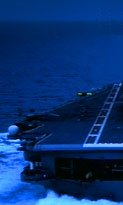 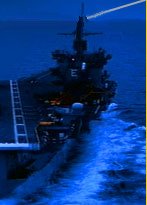 |
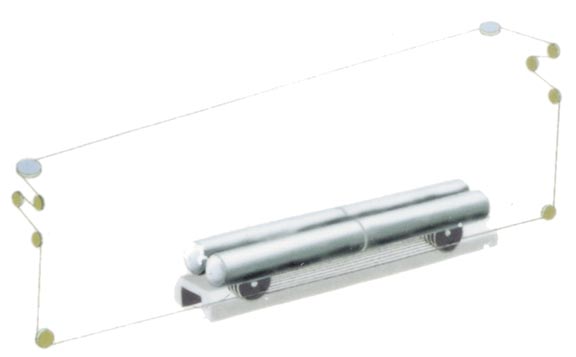
The design of naval aircraft starts with the airframe and landing gear, as they must withstand a tremendous shock each time the aircraft launches or lands. Each carrier-based aircraft has a tailhook, a hook bolted to an 8-foot bar extending from the after part of the aircraft. It is with the tailhook that the pilot catches one of the four steel arresting cables stretched across the deck, bringing the plane to a complete stop. The cables are set to stop each aircraft at the same place on the deck, regardless of the size or weight of the plane. Four 1.375-inch-thick steel cables run 2-5 inches above the deck at 35-40 foot intervals and connect with a hydraulic cylinder below the deck, which services as a giant shock absorber. As an aircraft approaches, all four wires are set to accommodate that aircraft's weight. When the aircraft's arresting hook snags a wire, the wire pulls a piston within a fluid-filled chamber. As the piston is drawn down the cylinder, hydraulic fluid is forced through the small holes in the cylinder end, thus absorbing the energy of the aircraft and braking it to a stop. An arresting wire can stop a 54,000-pound aircraft traveling at a speed of 130-150 miles per hour in a distance less than 350 feet. When the aircraft drops the wire, the piston is retracted and made ready to recover another aircraft in 45 seconds.
The ability of an aircraft carrier to remain on station in international waters for an extended period of time is a function of the Navy's logistic support forces. Although the ship carries great quantities of fuel, food and spare parts for sustained, unsupported operations, it must still be replenished on a regular basis. To resupply, Navy oilers and combat support ships bring boiler and aviation fuel, fresh food and weapons. Critical parts and mail are brought by C-2 cargo planes.
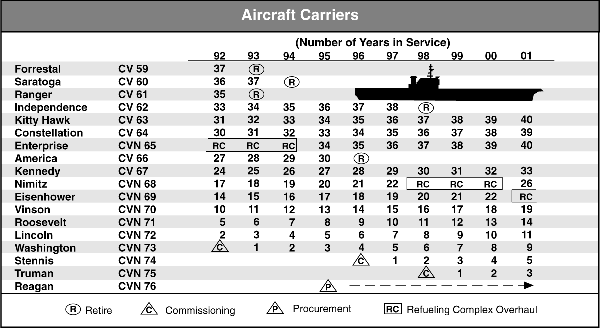

Decommissioning and disposal costs to inactivate a Nimitz-class nuclear carrier is estimated at $750 million to $900 million, almost one-quarter the cost of procuring a new Nimitz-class carrier. These costs are normally funded in the Navy's operations and maintenance appropriation account. The nuclear carrier inactivation cost is approximately 20 times the cost estimated for the decommissioning and disposal of conventional carriers currently in the fleet.
Annual Operating and Support Costs for
Nuclear-and Conventionally Powered
Carriers
(Fiscal year 1993 dollars in millions)
Annual
Carrier type cost
-------------------------------------------------------- ----------
Nimitz-class nuclear carrier $235.4
Kitty Hawk/John F. Kennedy class conventional carrier 196.3
===================================================================
Additional cost for nuclear-powered ship $39.1
-------------------------------------------------------------------
Estimates include the cost of initial nuclear fueling and refueling.
SOURCE: GAO/NSIAD-95-17
The Navy maintains at least three carriers deployed overseas most of the time, though three carriers constitute only one-quarter of the carrier fleet. In peacetime, some carriers are in repair; others are in US ports to provide stateside duty time for their crews; still others are in transit to their operating stations. But the Navy maintained five of its 13 carriers overseas in the late 1970s, and throughout the 1980s the Navy planned on a third of the 15-carrier fleet being deployed overseas.
Some policymakers contend that the United States does not need a force of 12 carriers, since US tactical airpower substantially exceeds that of any potential regional adversary. The Navy has a variety of ships other than carriers, including surface warfare units and large flat-deck amphibious vessels, that contributed to maintaining a U.S. naval presence in peacetime. In 1990, before the breakup of the Soviet Union, the Chairman of the Senate Committee on Armed Services recommended a force of 10 to 12 carriers. And during the 1992 campaign, President Clinton called for a Navy with 10 carriers.
In 1993 the House and Senate disagreed strongly over funding for the CVN-76 aircraft carrier. Finally, in a compromise, a process was agreed to whereby up to $1.2 billion was provided, instead of the $3.4 billion approved by the Senate. In March 1993, the Secretary of Defense initiated the Bottom-Up Review (BUR) of the nation's defense strategy, force structure, modernization, infrastructure, and foundations to evaluated defense needs in light of the end of the Cold War and the dissolution of the Soviet Union. The BUR concluded that a force of 10 carriers was adequate to meet war-fighting requirements, but 12 carriers (11 active and 1 reserve/training carrier) were needed to maintain overseas presence. This force level objectives were subsequently reaffirmed in the Quadrennial Defense Review of 1997.
The Bottom-Up Review also directed the Navy to evaluate "a full range of sea-based platforms to project air power and meet our military needs in the period 2020 and beyond." The Navy's Future Sea-Based Air Platform Study Group recommended that the Navy pursue a two-pronged strategy. In the near-term, the would acquire a 10th Nimitz carrier (CVN-77) to replace the Kitty Hawk (CV-63) when it retires in the year 2008. And the second recommendation was the development of a plan for developing follow-on, sea-basing platforms for the 21st century. This Future Carrier Assessment was to be a five-year effort funded at $159 million over 1996-2001. However, the Congress has declined to fully fund this undertaking.
The draft Naval Vessel Force Structure Requirements report, which was requested by Congress in 1999 and completed in early 2000, called for a fleet of over 360 ships, 44 more than in the current fleet. It would include 15 aircraft carriers, three more than now in service, and 68 attack submarines, a dozen more than in today's force. The Navy would have to spend up to $19 billion for 10 to 12 ships annually, roughly triple the FY2000 budget of $6.4 billion shipbuilding, which funded the construction of six new ships. The Clinton administration's FY2001 shipbuilding budget request for FY2001 was $10.7 billion for eight ships, in including more than $4 billion for the 10th and final Nimitz class aircraft carrier.